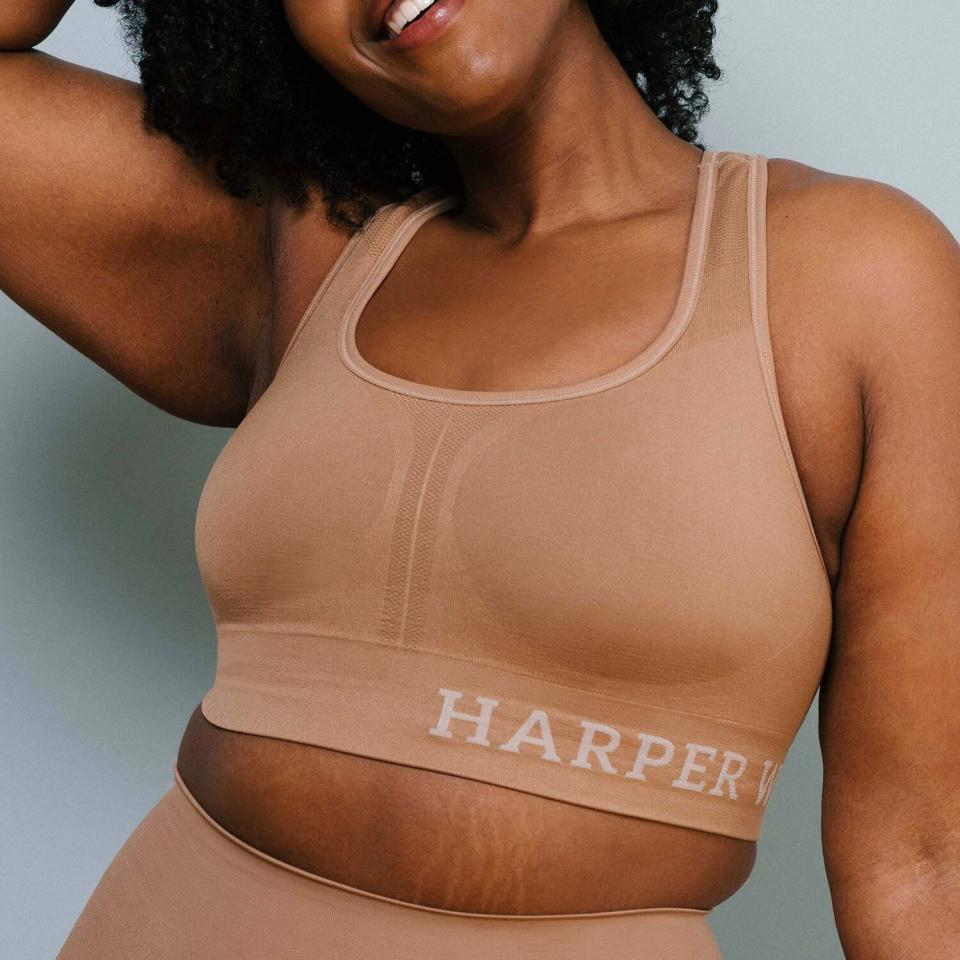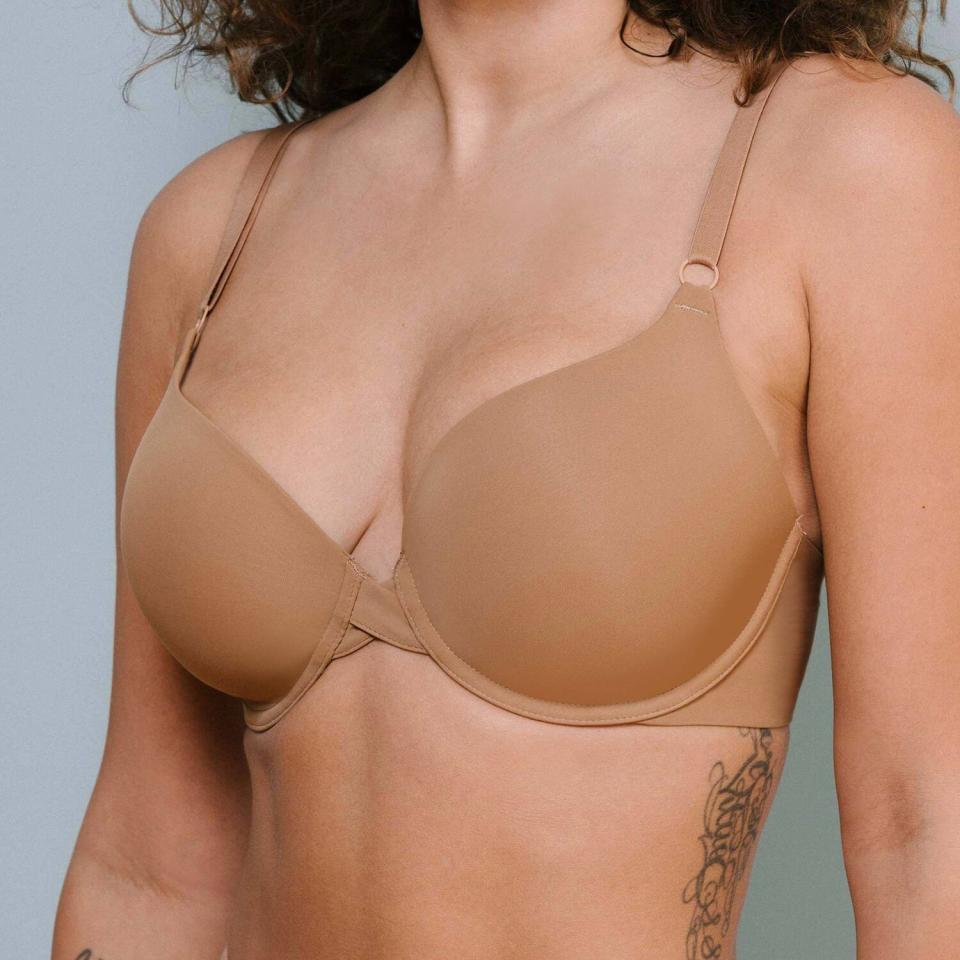Millions of Bras End Up In Landfills Every Year — Harper Wilde Wants to Repurpose Yours Instead
If you think about them in the simplest terms, bras are basically just two foam cups attached to an elastic band and some fabric straps. And yet, for reasons yet to be understood by those who are blessed with breasts, they cost a small fortune. Sure, you can drop just $15 on a lightly lined option from a big box store, but you know it won't last as long or fit as well as something pricier. Opt for something a bit higher quality, and you might spend upward of $60 for a single boob-holder.
No matter how pricey of a bra you choose to strap on day after day, it'll still come at a high cost to the environment. Most bras are made from nylon — a strong, wrinkle-resistant synthetic material that can take 30 to 40 years to degrade once you toss it in the trash — or polyester, a soft, cheap synthetic material that can take anywhere from 20 to 200 years to break down. The little snaps, hooks, and slides are typically made from metal (such as steel or aluminum) or plastic, which can take up to 200 and 400 years, respectively, to decompose. All that's to say your bra is going to hang around long after the strap breaks and you drop it in the garbage can. (Unless you shop sustainably, so will your activewear.)
All this scrapped material adds up: Eighty-five percent of clothing is sent to landfills or incinerated (which releases pollutants into the atmosphere that contribute to global warming, acidification, and smog formation) after use, according to the New York State Department of Environmental Conservation. Even those who tend to donate their too-small jeans or out-of-style tops might not be able to do the same for their well-loved bras, as donation centers, such as Goodwill, often don't accept used undergarments. Think of it this way: If 85 percent of women in the U.S. tossed just one bra in the trash, landfills would contain up to 141.7 million bras, many of which just sit there for several hundred years.
Thankfully, there are a few solutions to this little-noticed environmental problem. The easiest would be to go entirely braless and let your girls hang freely. Still, boobs left unattended, particularly large, heavy breasts, may put excess strain on the muscles underneath the breasts, which can ultimately cause chest, back, and shoulder pains and poor posture, Andrea Madrigrano, M.D., a breast surgeon and associate professor of surgery at Rush University Medical Center in Chicago, previously told Shape. Going au naturel on a jog can cause your gals to bounce around, potentially leading to pain and discomfort, too. Wearing a bra, however, can give your boobs the support they need to minimize any strain and prevent these aches and issues, so if you're going to strap one on, turn to Harper Wilde's Recycle, Bra program. Launched in 2019, the brand's bra recycling program makes it easy to dispose of your worn-down undergarments in an eco-friendly way: When your bralette, sports bra, underwire bra, wireless bra, or nursing bra — regardless of brand or style — is at the end of its life, simply download a shipping label from Harper Wilde's site and send it off to the company. (If you're mailing your bra off to be recycled without purchasing a Harper Wilde bra first, you'll cover the shipping costs.)
Once Harper Wilde receives your bra, the company will pass it along to its recycling partners, some of which separate the hardware from the fabric and foam components while others transform it into new clothes, rugs, cleaning textiles, building insulation, couch stuffing, and carpet padding, according to the company. Since the initiative began just two years ago, the program has already had a profound impact: The brand has saved more than 38,000 bras from reaching landfills this far and is on track to recycle 50,000 by the end of 2021.

Anyone can send the company their used bras for recycling, but the process is even easier — not to mention, free — if you first buy a new bra from Harper Wilde. In that case, the company will also give you a Recycling Kit — including a corn-based compostable bag (which breaks down into fertilizer, not harmful microplastics, when properly disposed of) that you can use to mail your three-year-old, sweat-stained bras back to them — and a prepaid shipping label. If you live in Los Angeles, New York City, Chicago, Dallas, or Tigard, Oregon, you can now drop off your used bras at Harper Wilde's "Bra Bins" inside your Nordstrom store — the direct-to-consumer brand's first and only national retail partner — no purchase required. (Related: Nordstrom Launched a New Recycling Program for Beauty Product Packaging)
While stuffing your two-sizes-too-small bras into a bag and taking the time to stop at the post office can feel like just one more thing to add to your to-do list, after that first recycling experience, it'll feel as routine as heading to the grocery store to return your empty seltzer cans. Plus, shipping your bras off to have a new life as a couch cushion gives you the perfect excuse to invest in a Harper Wilde sports bra (Buy It, $45, nordstrom.com) or a classic underwire bra (Buy It, $40, nordstrom.com).

Harper Wilde
Buy It: Harper Wilde The Move Sports Bra, $45, nordstrom.com

Harper Wilde
Buy It: Harper Wilde The Base Underwire Bra, $40, nordstrom.com

